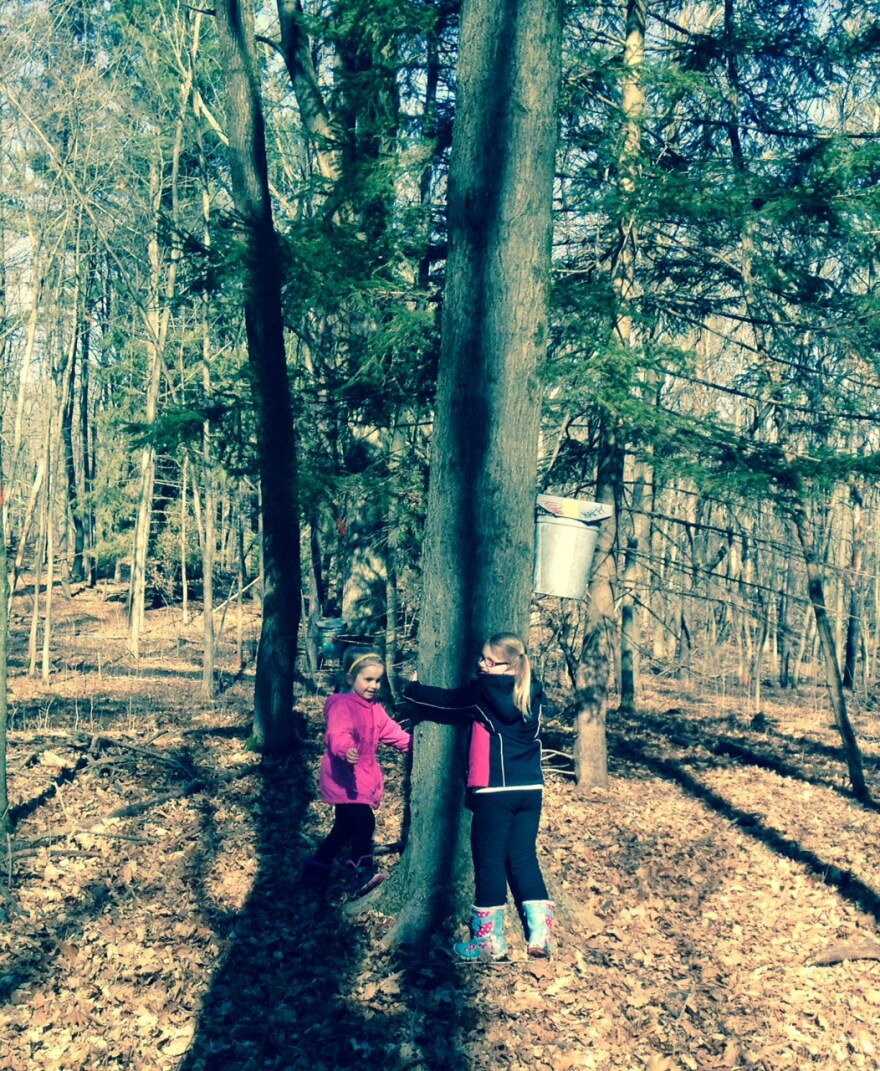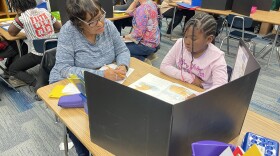It started in 1970 outside the small town of Newburg, two years after the Whitefish Bay Women’s Club purchased the first parcel of land. It gradually morphed into 379 acres stewarded by Riveredge Nature Center.
Earlier this month a couple hundred kids – mostly Scouts along with some tag-along parents and leaders – experienced some of the science and lore of maple sugaring.
Small clusters of Daisies swarm the parking lot.
Port Washington resident Denise Schueler is in charge of five of them Schueler calls her troop part of the lucky few.
“We get the newsletter and I saw actually a couple of years ago. I’ve been trying to get in and this is the first year I was able to get in. It’s pretty popular,” Schueler says.
Minivans continue to spill out young third-gradish girls – their faces filled with variations of wonder and bewilderment.
Before the morning is over, the Scouts will learn to identify maple trees, explore the wonder of photosynthesis and help tap a tree. They’ll also see how sap is boiled down to syrup right in the Riveredge forest and feast on a “made from scratch” pancake – WITH maple syrup naturally.

Down deep in the maple bush – that’s an insider term – a small seasoned crew prepares for the onslaught.
It takes an aquatic biologist and school administrator – both retired from their first professions to handle the syrup-making and pancake flipping part of the operation. Eric Oleson has been here 16 years.
“We work year-round part-time doing maintanence. Yeah, I retired and was looking for something to do. Leftie called me,” Oleson explains that’s fellow crew member Richard Fowler. He’s a retired Grafton High School phy ed teacher and coach.
“He said are you looking for some work? We could use some help. I’ve been here ever since,” Oleson says.
Recent seasons have produced smaller yields, but Oleson says if the sap is running “then we’re collecting and transferring and cooking it. There have been years when we’ve gotten 2500 gallons of sap in a week, and then we’re working 16 hour days sometimes, because you can’t let it sit very long; it starts to spoil,” Oleson says.
Every drop of what is harvested is either served up right here with pancakes or is bottled. “After the season is over, the syrup is in gallon jugs. We take to our kitchen (at Riveredge’s home base) and reheat, check for sugar content and then bottle it,” Oleson says.
But those days seem distant; right now the troops are coming.
Riveredge environmental educator Lauren Wendland sends me in the right direction to intercept them.
“They are taking their little tour and learning tree I.D. and maybe a little bit about the Native Americans and the earlier settlers. If you walk this way, you’ll find them,” Wendland says.
Volunteer Pat Fairchild has 10 years under HER belt – she guides her cluster of kids toward a giant tree, pointing out its sugar maple characteristics, including its bark.

“See you it’s sort of gray, not real white or black. If you look way up, way up at the top, see how fine those little twigs are,” Fairchild says.
This specimen has already been tapped. A large metal bucket hangs from a “spile” – the little spout tapped into the maple.
Fairchild invites the kids to sample the watery sap. (It takes some heavy boiling to reduce to its sweet essence).
“If you take your glove off, you can put one finger in. One finger in and taste it. But you can’t double dip, just one taste,” Fairchild instructs.

Fellow instructor Phyllis McKenzie fuses her troop with Fairchild’s. McKenzie attempts to corral them all, divide into even smaller groups in order to search of a yet untapped maple. She looks on as the Scouts scatter and squeal, throwing their arms around trees. Sunlight cascades through the canopy.
Part of McKenzie’s energy goes to preserving a diverse tree scape.
“Our sugar bush is in decline; we’ve tapped it and tapped it for 40 or 50 years. This one is crowding the oak, we want to give it room. A lot of the trees that are marked are ash that have died from Emerald ash borer,” McKenzie says.
She says Riveredge has fashioned a complicated canopy management plan.
“We’ve got portions we managing for diversity, portions we’re managing for sugar bush; some areas are distinctly oak hickory woods. We’ve been working with UW-Stevens Point. Students from the forestry department. They’re marking and identifying trees,” McKenzie says.
An untapped tree has been selected. Pat Fairchild prepares the “patient.”

“We’re going to spray some alcohol on this. Kind of like when you a shot from the doctor, they always rub you with alcohol. We don’t want any dirt from the outside the tree to get inside the tree,” Fairchild says. She gives the hand drill she holds a dose for good measure. Then each child gets a turn – two rotations each – to help drill into the bark.
The kids eyes are riveted as Phyllis McKenzie inserts the spile and hooks on the bucket. They’re hoping to drops of sap. Not a one!
McKenzie has her finger at the ready under the bucket. She demonstrates – with a tap, tap, tap – the sound sap. You can almost SEE it flowing.

The smell of pancakes breaks the spell. It’s time to sample the syrup.
Back at the Sugar Inn the crew doles the treats out by the small paper plate full.
Do you happen to remember that retired aquatic biologist I mentioned earlier? At Riveredge, Don Gilmore is called the Big Sap.
How did he land here? “There was an ad in the paper for somebody to do maintenance…..,” Gilmore says.
Gilmore has led maple sugaring for over three decades. Magic, he says, is to blame.
“The month of March is magic. You’re taking clear stuff from the trees and turning it into maple syrup. You’re not adding anything, but a little heat – maybe a lot of heat. It’s just a magic time of year,” he says.
Enough nonsense, Gilmore says! The Riveredge crew needs to prepare for the next round of Scouts.











